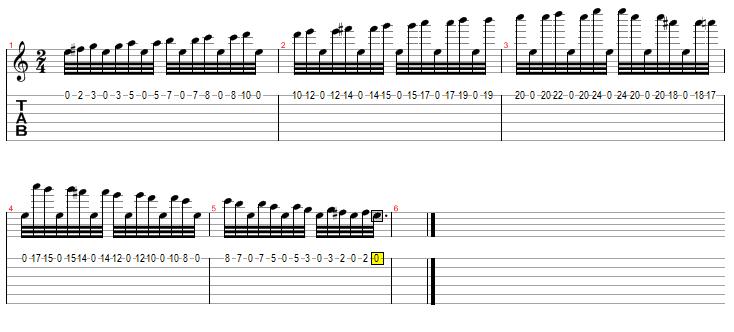E Natural Minor Scale And Its Related Pentatonic Scale
 The sole purpose of this article is to help you understand the minor scale in more depth and master the E minor scale across the entire guitar neck. Since we are talking about the natural minor scale, the first step would be to determine which notes it holds.
The sole purpose of this article is to help you understand the minor scale in more depth and master the E minor scale across the entire guitar neck. Since we are talking about the natural minor scale, the first step would be to determine which notes it holds.
We can do that in 3 easy ways:
1) Use the formula W, H, W, W, H, W, W (or 1, ½, 1, 1, ½, 1, 1) to extract the right notes from the chromatic scale, starting from the note E.
2) Compare it to major scale, so you get the formula 1, 2, 3b, 4, 5, 6b, 7b. Meaning, take E major scale and flat the 3rd, 6th and 7th interval by half step, to get E natural minor scale.
3) Take G major scale, and start it from 6th interval (E note). This works because E minor is a relative key to G major
Either way, you will get the following notes and intervals:
1st – E
2nd – Gb
3rd – G
4th – A
5th – B
6th – C
7th – D
Now that we’ve got the notes, we will locate them on guitar fretboard. I will cover the whole guitar neck with notes of E minor scale, but in steps, so you won’t have much problem with learning them. Trying to learn all notes on the neck at once is ridiculous, anyway.
Step 1 – Notes on 1st String
When you put the notes of Em scale on first string, you already have this: natural minor scale.

Note!! You should do these diagrams yourself, by hand, on some paper or something, and DON’T FORGET to put which notes belong to which fret, and try to learn which interval they present, also!
To overcome those note positions, try to use exercises like this one:
 When doing these kinds of exercises, speak or sing the notes you play, you will get them quickly this way. Also, try skipping some notes in similar runs, try legato… The more you practice on these notes, the sooner you will remember them.
When doing these kinds of exercises, speak or sing the notes you play, you will get them quickly this way. Also, try skipping some notes in similar runs, try legato… The more you practice on these notes, the sooner you will remember them.
Step 2 – Notes on 6th string
When you do exactly the same thing as before, you get this as result:

You should perform the same exercise for 6th string, as you did for 1st.
Step 3 – Em pentatonic
If you take 1st, 3rd, 4th, 5th and 7th interval of natural minor scale, you get minor pentatonic scale. Notes of E minor pentatonic scale are E, G, A, B and D.
Starting from E notes on 6th string, you get the following diagrams:

Practice those well. Both descending and ascending, in as many runs and combinations as you can think of. They will become your basis for soloing later on.
If we add those notes to the notes we have from before, you already have this:

The notes rounded by the yellow line are a connection between Em pentatonic and Em (on first string). You would be surprised by how much solo licks you can make only on these notes!!
Step 4 – Em pentatonic from E note on 5th string
If you go from E notes on 5th string, you get Em pentatonic with the following pattern:

Dedicate your time to overcoming this and the last position of this scale. Without getting this you won’t go through the next step that easily. Anyway, if we put all those notes we know already together, it looks like this:

Rounded in green are the notes that connect Em pentatonic from 6th string with Em pentatonic from 5th string. Connecting your past knowledge with your new one is extremely important in overcoming the scale through whole neck.
Rounded notes form 5th pattern (notes of 5th mode) of Em pentatonic scale, meaning you take Em pentatonic scale, and start it from its 5th note (D note). Try improvising and connecting all 3 pentatonic patterns; 1st pattern from 5th string, 5th pattern from 6th string and 1st pattern from 6th string.
Step 5 – First 6 notes of Em scale through 3 notes per string patterns
Before we go any further, you have to learn where all E notes on your fretboard are, and you must know them anytime, anyday, anywhere! Here they are (Yellow are more important than blue notes, because they are simply easier to remember, and hold more guitar soloing options, which you will realize through practice):

You will also need to know the pattern for the first 6 notes of Em scale through 3 notes per string:

Green is the 7th, which we won’t use right now, and blue is an octave, from which you can begin the pattern again, of course.
Now, implement that pattern (while thinking in notes, of course) on all the yellow E notes. You will get this:

I suggest you stay at this one for a few days. Practice each pattern separately, and be sure to have memorized them all (in notes) before you continue.
Now, don’t go learning all over again through the blue notes. Just expand the pattern down to blue note, and start from it all over again. Also try practicing this through 3 octaves. This way you get:

Step 6 – Implementing 7ths and notes of 24th fret (if you have it)
The only thing now left to do is to add notes on 24th fret and 7ths to your diagrams. Do it through practice, tough. Play those 3 string patterns, but now add 7th before you go to next octave. Also play pentatonic scales and add those missing 7ths to them.
It is a very good sounding thing when you’re playing in minor key, to play sixth, bend it up to 7th and release string bending, and then go to 4th to eventually end on 1st, 3rd or 5th. Practicing similar things will get 7th in your fingers, not only in your head.
So now, you have learned E natural minor scale through the whole guitar neck!!

Guitar Lessons Guaranteed to Help You See Massive Improvements!

Jamplay is the BEST online guitar lesson website that offers step-by-step videos in high definition. They cover EVERY genre of guitar styles and have exhaustive content for musicians of any skill level.
Jamplay also showcases a continuously growing archive of video lessons that are updated weekly. In addition to that, they also offer detailed tutorials for members to learn popular songs with the help of precise, dynamic tabs and song visualizations.
p.s: We have set up a wonderful deal for GuitarPlayerWorld.com’s visitors. Get your exclusive Jamplay promotion code here…
Related Articles
Leave A Comment






One Comment
This is very helpful to learn perhaps the most beautiful and useful scale on the guitar. May I add a small trick to practicing that sounds a little surprising .. In the key of E minor you can do a pull-off from every fretted note at the twelfth fret to the open string, and get a “dual” minor pentatonic sound. Very effective sounds. If your guitar has the 24 frets, you can probably get a two octave pull-off of all e minor pentatonic notes with a little more work . Suggest trying it.